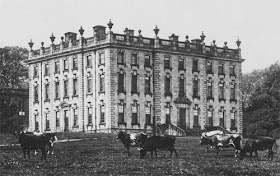This week marks the 40th anniversary of the famous V&A exhibition in 1974, which changed public perception of the country houses. Though the Country Estates series usually covers extant buildings, this post focuses of a few of the thousands of houses which were destroyed or abandoned during the 20th century.
Many families succumbed from decreased estate incomes and crippling death duties, especially when 2 generations of heirs died within quick succession; and unlike the great treasure houses of Britain, such as Chatsworth, Houghton, Bleheim and others, the government refused to accept works of art, land and other assets in lieu of death duties, meaning many families were forced to abandon their homes, some even razing them to the ground.
I must credit Mr Matthew Beckett for many of the following photos from his amazing site cataloging most of these 2000 lost houses.
Above: Bowood House, Wiltshire. Home of the Marquesses of Lansdowne. The main house seen on the right of the photo no longer remains, although the part of the left which opens on to the terrace still survives.
Above: Hamilton Palace, South Larnarkshire, Scotland. Country seat of the Dukes of Hamilton until it was demolished in 1927.
Above: Tong Castle, Shropshire. Once home to the Earl of Bradford. Demolished 1957. Now tarmacked over as the M54 motorway!
Above and Below: Trentham Hall, Staffordshire. Once home to the Dukes of Sutherland, and Suffolk. Abandoned in 1905, some of the stone sold off, and building to be pulled down as of last year.
Above: Blythswood House, Renfrew, Scotland. Home of the Lords Blythswood until it was demolished in 1935.
Above and below: Mavisbank. Left gutted by a fire in 1973 is now a junkyard, although it had fallen into disrepair long before the fire.

Above and Below: Eaton Hall, Cheshire. The Country seat of the Dukes of Westminster. There is still a country house there, but the Hall shown in the pictures above and below was the 4th Hall built on the site, known as the Waterhouse Hall (after the architect). It was built by the first Duke of Westminster in the late 1800s and pulled down down the 5th Duke in the 1970s, who commissioned a monstrous modern fiasco, which was so hideous it subsequently had to be disguised as a French Chateau in the 1990s.
Below: Carclew House, Near Falmuth, Cornwall. Razed to the ground in 1934
Above and Below: Wingerworth Hall, Derbyshire. Demolished in 1927
Above: Pyrgo House, north east London. It was built in 1852, Demolished in 1941.
Above: East Cowes Castle, 1798 - 1960. Was designed by and the home of famous Architect John Nash.
Garendon Hall, Leicestershire. Built 1734, demolished in 1964. Like so many houses lent to the army during the second world war, was damaged severely, and not repaired.
Above and Below: Gopsall Hall 1750 - 1952. Built by Charles Jennens, the house was later to pass into the hands of the crown, last being occupied as a radar base during WWII before falling into disrepair and being demolished. The garden temple pictured below was where Handel is rumoured to have written much of his Messiah.
Above: Fineshade Abbey, Northamptonshire. Demolished in 1956. It had been damaged during use as a POW camp during WWII. Only the stable block (below) remains.
Below: Tusmore Park, Oxfordshire. Demolished in 1960 by Randall Smith, Second Baron Bicester.
Below: Leaton Knolls, demolished in 1955.
Below: Butterton Hall, Staffordshire. Demolished in 1924 due to damage sustained during army requisition during WWI.
Below: Whitley Court, Worcestershire. Lost to fire in 1937.
Whitley Court was one of the most splendid houses of the 18th century...
And then the fire struck...
But the ruins still remain.
Below: Stanwick Hall, Northamptonshire
Do please visit Mr Beckett's site for information on many more of Britain's lost houses.





.JPG)






.jpg)

















.JPG)






well that is depressing :-(
ReplyDeleteThe Eaton Hall of the 1960s was all the worst of modernism, but I'm not convinced that the French chateau facade is that lovely either. As for the rest, although their destruction is sad when there was architectural merit, they were of course reliant on an army of servants to run them comfortably for a very few people, and I think the social changes that took place to allow those in service to find other employment were no bad thing. Domestic service was an extraordinarily large sector at the beginning of the C20th. WWI of course altered that perception quite dramatically.
ReplyDeleteI loved what you did with this. So many pictures I've never seen before including the heartbreaking photo of the junkyard. Beautiful job. I can't wait to look more deeply into the Beckett site, I only peeked after reading the Lost houses book last month...
ReplyDeleteA great list and quite emotive. I am however, surprised Alton Towers is not listed.
ReplyDeleteSo so sad, short sighted , I can only be glad that today in our modern era we have found the foresight to preserve what is all part of our British history, nevertheless the sadness prevails for what was lost due to political sociological tax punishments.
ReplyDelete